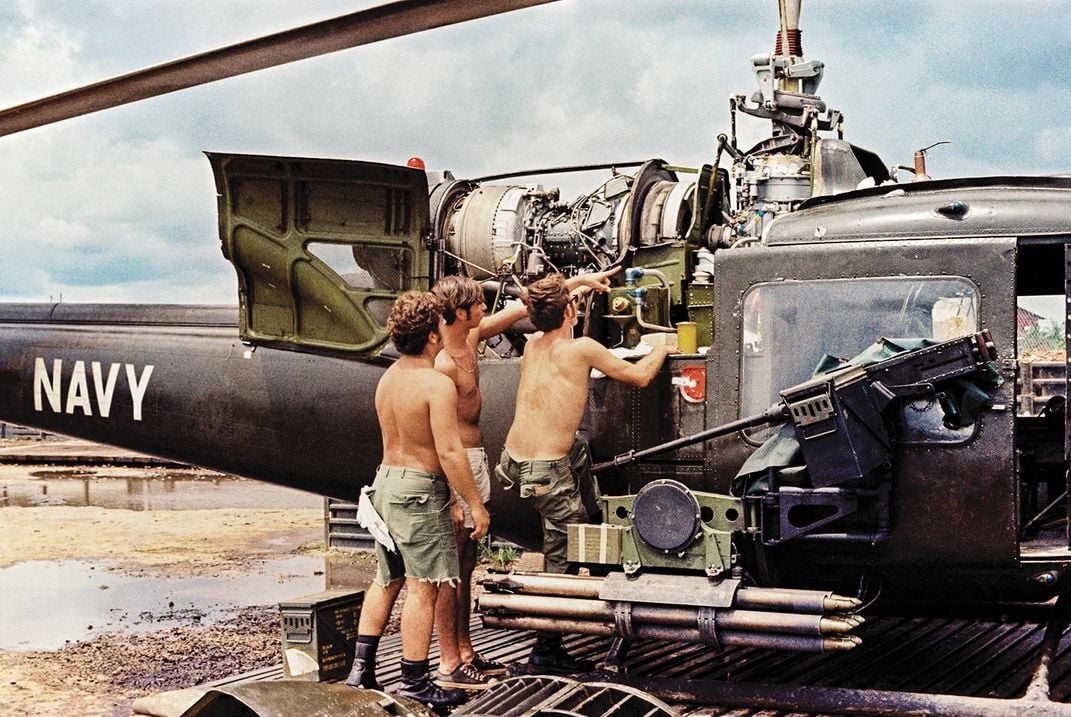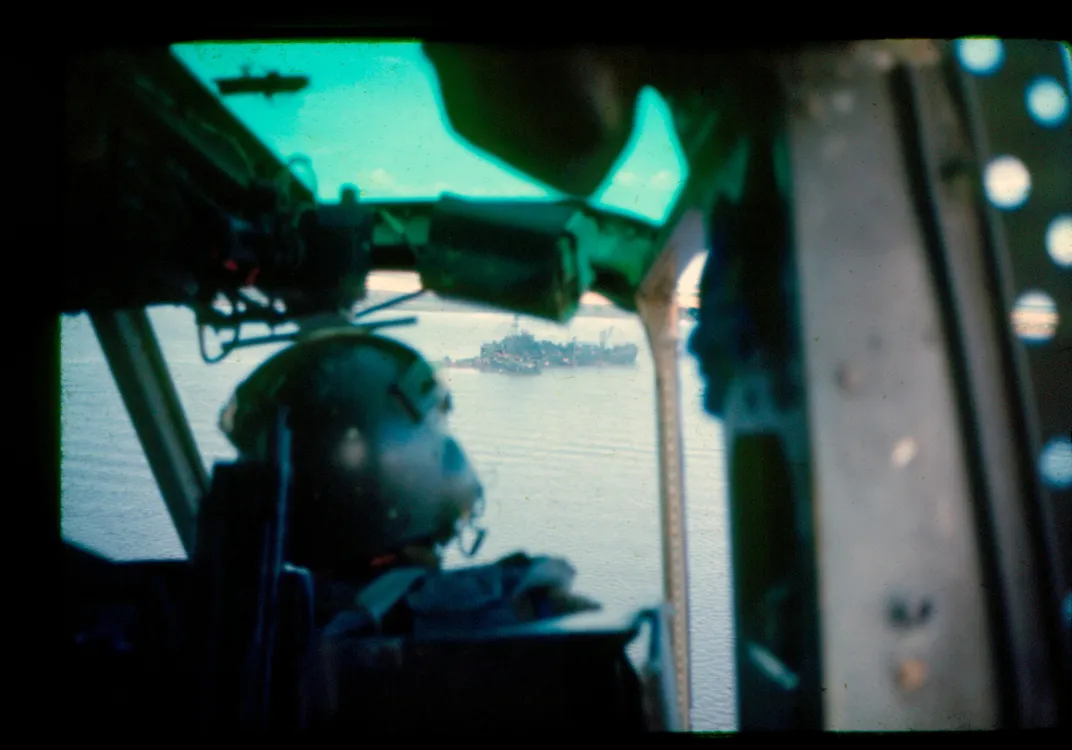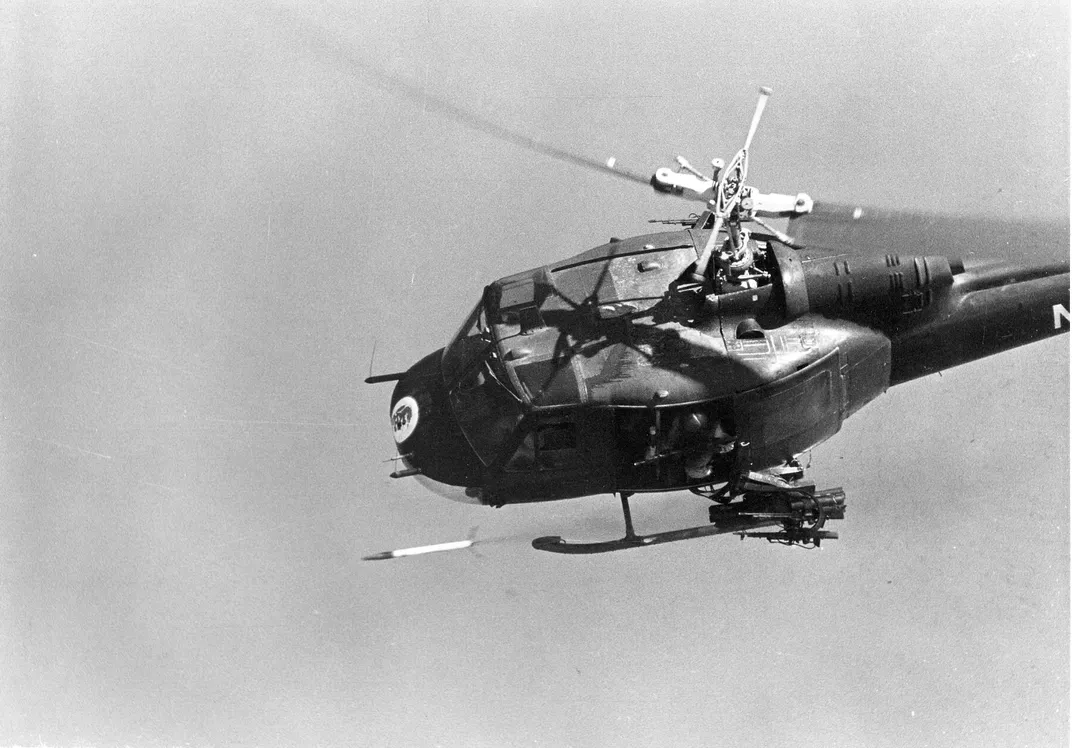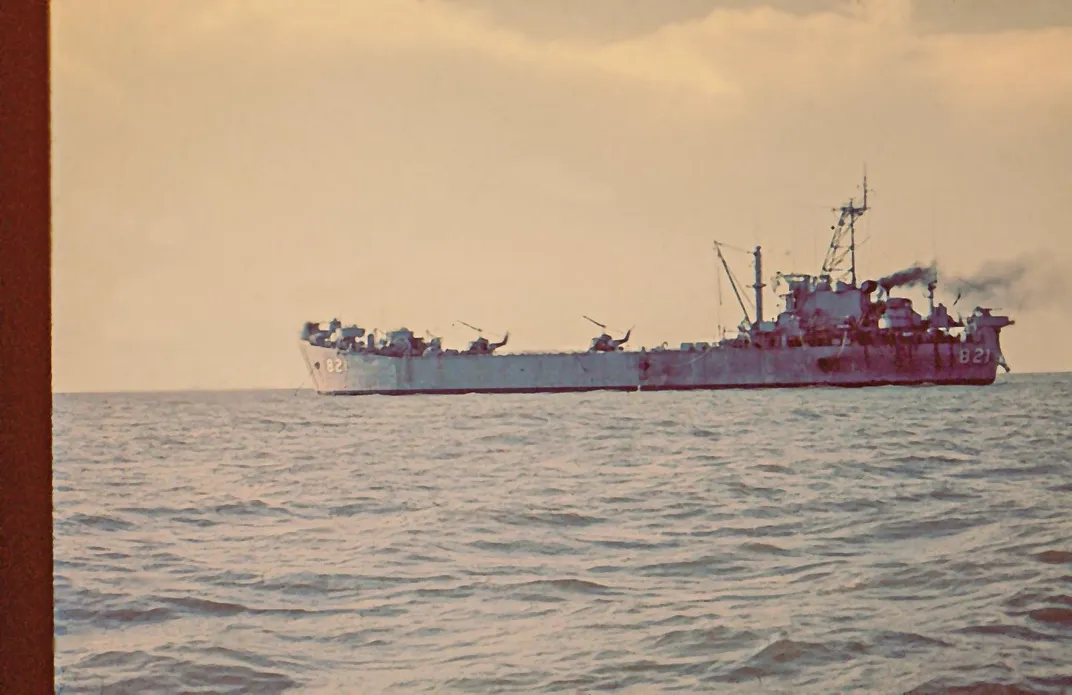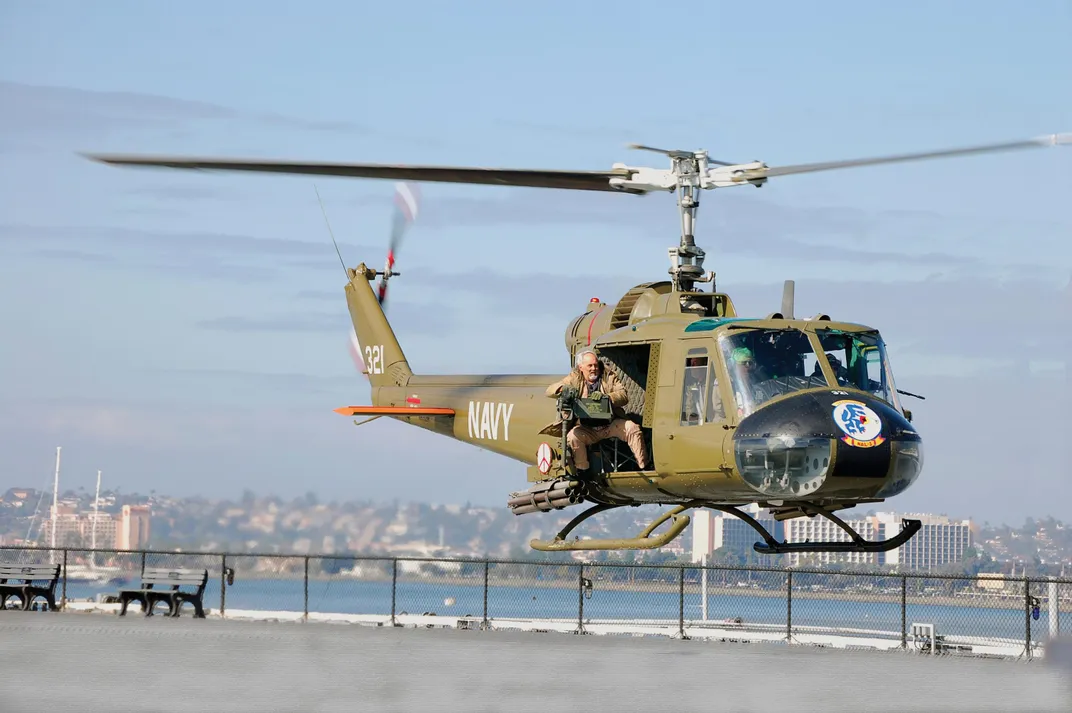Scramble Seawolves!
When Navy SEALs in the Mekong Delta needed help, salvation came from a pair of beat-up Hueys.
/https://tf-cmsv2-smithsonianmag-media.s3.amazonaws.com/filer/12/02/12026319-14ad-4375-b50c-5691546fec93/06b_am2016_2hal-3uh-1evn_live.jpg)
The Mekong Delta is a vast, swampy system of more than 2,500 miles of rivers, canals, and streams covering the southern quarter of what was, before 1975, the Republic of South Vietnam. During the Vietnam War, whoever controlled the waterways controlled the area, and in 1965 communist forces did; the Viet Cong and North Vietnamese army (NVA) funneled troops and supplies around with near impunity.
That year, the United States, in the midst of a massive military buildup in Vietnam, began Operation Game Warden to take control of the waters. SEAL teams went in, backed by flotillas of river patrol boats (PBRs). Flat-bottomed, World War II-era amphibious ships, able to navigate the rivers, were hauled out of storage and reconfigured to serve as floating bases—one-stop shops with everything commanders needed.
The enemy fought back fiercely with armed junks and ambushes sprung from concealed positions ashore. To survive, the boat crews and special forces teams would need close air support, and the aircraft best suited for the job were dedicated helicopter gunships. There was just one problem: The Navy didn’t fly gunships.
In early 1966, Army UH-1B Huey gunships were temporarily assigned to a dock-landing ship, the USS Belle Grove, to support Operation Game Warden. The Army aviator’s tenure on the ship was only about five months, but the men used the time to develop many of the tactics later used by the Navy, and gave their contingent a nickname: the Sea Wolves (later compressed to one word: Seawolves). When the Army left, the Navy kept eight of their helicopters—and the nickname.
The Navy crews, trained by the Army and equipped with the borrowed Hueys, got into their first big battle on October 31, 1966, when two patrol boats stumbled upon a fleet of around 80 sampans and junks that were transporting a Viet Cong battalion. In the ensuing battle, the Seawolf gunships sank 15 boats. Both PBR crews made it out safely (one boat crewman was awarded the Medal of Honor), and the Viet Cong suffered heavy losses. These seasoned crews formed the nucleus of the Navy’s only dedicated helicopter gunship outfit of the Vietnam War, which on April 1, 1967, was formally anointed Helicopter Attack (Light)-3. Equipped with the UH-1Bs (by that time retired by the Army in favor of newer models), HA(L)-3 was split into seven detachments (later expanded to nine) that were scattered throughout the Mekong Delta, based afloat or at small outposts on mosquito-infested riverbanks. For mutual support, two helicopters always flew together in what were called fire teams, with two crews per helicopter on alternating 24-hour alert shifts. Detachments (“dets”) were expected to be self-supporting, so the gunners also served as maintenance men. “We were all selected from different trades,” says Mike Dobson, an aviation electrician’s mate–turned–gunner. “Everything was done in-house.” The crews were tasked as the primary quick reaction force for PBR crews or SEALs in trouble.
The waterways had few radio navigation aids or outstanding landmarks, so learning the pattern and layout of the waterways was critical. Fire teams patrolled up to four times a day to familiarize themselves with their operating areas. Like cops on a beat, they came to know their neighborhood’s routines intimately. Seawolf gunships were among the most heavily armed Hueys in Vietnam. In addition to the door gunners, there were one or two forward-firing machine guns and a rocket pod on either side. Although the 2.75-inch folding-fin rockets packed the biggest punch, many pilots considered door gunners the best weapons aboard. “The Seawolf claim to fame was its gunners,” says pilot Tom Phillips. “Our door gunners were astonishingly accurate, and could quickly rearrange an enemy’s priorities from shooting us down to survival.” The helicopters were unprotected from behind, and the Viet Cong quickly learned to let them pass overhead before opening fire. In response, door gunners developed an unofficial technique: Once the enemy started shooting, they stepped outside onto a skid with a customized M-60 light machine gun in their arms.
As the Seawolves became known in the delta to friend and foe alike, the Viet Cong grew more cautious whenever a helicopter was overhead. “I heard that a Viet Cong bounty was placed on aircrew types, and that Seawolves were on top of the list,” says gunner Gary Ely. “That was always on my mind.” (Among aircrew in Vietnam, such rumors were common but largely unproven.)
Floating Bases
Flying the underpowered, overloaded Hueys from the converted ship’s tiny helipads was a challenge.
During launch, if the winds weren’t just right, the gunship would dip dangerously close to the water. Any Seawolf veteran invariably mentions the region’s heat and humidity, conditions that degrade a helicopter’s performance.“We had some pretty damn good pilots in the seats of those Hueys,” reminisces Ely. “I flew with plenty before and after, and rarely were any as good.”
Weight was so critical that sea-based gunships reduced their fuel and weapons loads, compared to what their land-based counterparts carried. Gunners became adept at quickly jettisoning rocket pods and/or dumping ammo boxes whenever they felt they were about to crash—which they occasionally did.
Those takeoffs “were thrilling, I’ll tell you,” says gunner Bob Christenson. Pilots, too busy flying to make the jettison call, depended on gunners who would. “Every takeoff, I would have my finger in the jettison ring of my side’s rocket pod,” Christenson recalls. “The other gunner would be ready with his. I dumped pods once, ammo boxes more often. It was something I never expected to be doing in my life.” Christenson said he knew when they were in trouble by the rotor’s sound and “hair rising on the back of my neck.”
“Nighttime takeoffs were the hairiest,” remembers pilot Rick Sadlier. “We were on instruments from the time we got a launch signal, and it was blacker than hell out there. Dipping nose-down over the side of the ship was like flying into a cave.”
Tet ’68
Jack Williamson was a door gunner with a Seawolf detachment flying from an Army airfield near the Vietnamese provincial capital Vinh Long. In January 1968, despite a weeklong ceasefire so both sides could celebrate Tet, marking a new year on the Vietnamese lunar calendar, there were persistent rumors that the Viet Cong were going to hit the base. On January 30, an Army gunship had to make an emergency landing next to the Seawolf compound; it was so shot up it seemed an omen. Williamson helped lift a wounded gunner out of the Huey. The pilot of the gunship asked, “Are you a gunner?” When Williamson answered yes, the response was a terse “Get in.”
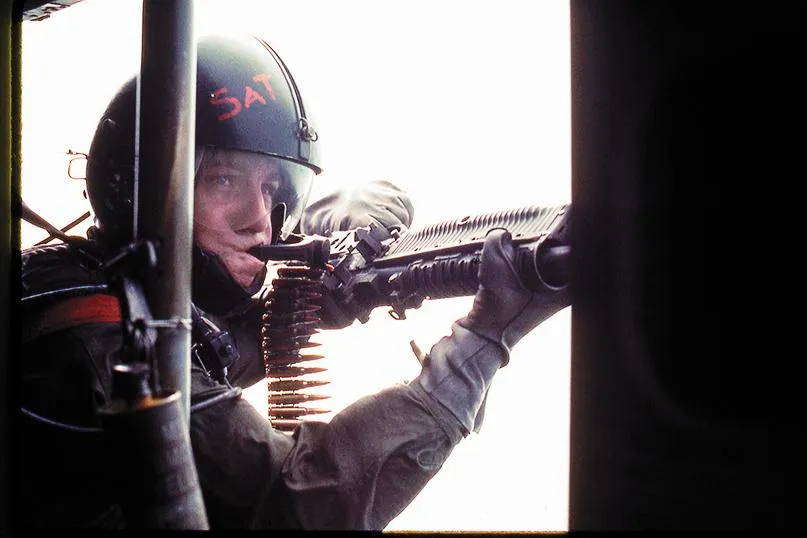
Later that night the rumor came true: Vinh Long was hit as part of a massive series of attacks all over South Vietnam, and what became known as the Tet Offensive was under way. “All hell broke loose about midnight,” recalls Williamson. “Charlie was on the base, it was bad, with bullets flying and mortars landing everywhere.” The base commander and his first sergeant were killed, and the airfield nearly overrun. “We took a lot of casualties,” says Williamson. “I saw a lot of body bags filled with our guys.”
With the Army short-handed, Williamson spent the next few days flying with them in a grim fight to save the airfield and nearby garrisons. One mission involved escorting a Dust Off medevac chopper to Song Phu, a village that had been overrun and burned down by the VC. On a bridge hastily fortified with an armored vehicle parked at each end, surviving defenders and their U.S. Army advisers were making a last stand.
The Army Hueys approaching the bridge began taking small arms fire. “We took four or five rounds through the belly of the gunship,” says Williamson, “and when we took hits through the floor, you’d feel it.” Williamson remembers shooting along the treeline, trying to keep enemy heads down. The medevac picked up a wounded soldier and hurried to the nearest hospital. Williamson, then 20 years old, was the “old man” aboard; the others on the helicopter were only 19.
Once back with the Seawolves, Williamson was in continual combat. “There were 16- to 18-hour days where I came back blackened by gun soot,” he says. “Army guys were great, but our pilots were better trained for night missions, so we flew a lot of nights during Tet.”
Fast off the Mark
When the call “Scramble Seawolves!” went out, crews prided themselves on getting airborne quickly, the goal being two minutes or less. Pilot Tom Phillips still recalls his personal best: “From rack to air in 90 seconds.”
“Everything was set up and ready to go,” says Gary Ely. “We slept near the birds, so we could scramble in two to three minutes when the horn went off.”
Most days followed a routine. “We’d start out in the morning,” says Jack Williamson; “If we didn’t have any calls to respond to we’d just patrol up and down the river. Most of the time those patrols turned into being fired on. We’d go into action for a short time, but occasionally it was just a quiet up and down the river. Basically it was the same thing every day.” The Seawolves hauled supplies to remote outposts, provided air cover to PBRs, and acted as taxis for SEAL teams. But sometimes they were called for tasks they didn’t expect and weren’t meant to do.
While leading a patrol along the Bo De River in the summer of 1969, Lieutenant (junior grade) Rick Sadlier received a call from a PBR that had been ambushed from hidden Viet Cong shore positions. Fighting their way out with a gravely wounded sailor aboard, the patrol boat skipper called for an immediate medevac. Sadlier promptly led his fire team into the fight, firing guns and rockets to suppress enemy fire. “We were not normally in the business of rescue,” says Sadlier. With his wingman laying down covering fire, Sadlier hovered over the bobbing stern of the moving boat as sailors hoisted their wounded shipmate up toward the helicopter.
Between shoreline and helicopter, a web of tracer fire—red from the American guns, green from the enemy’s—filled the sky. While one of the gunners blazed away, the other reached down and pulled the wounded sailor aboard. Sadlier watched as tracers from an enemy heavy machine gun arched toward him. “They looked like tennis balls coming at me,” he recalls. After perhaps two anxious minutes, the sailor was safely aboard. Sadlier dipped to the left and skimmed the trees until the gunfire was safely behind him. The Huey escaped unscathed and delivered the wounded sailor to a field hospital in Binh Thuy.
Even by military standards, the Seawolves were a close-knit bunch, all volunteers, mostly young. Bill Rutledge had retired from a tour as an enlisted man in the Navy, but missed life in the service. “I was hot and bored in Missouri when I heard about the Seawolves,” he says. “At the recruiter’s office in St. Louis, they told me ‘Sign here. Now go get a haircut.’ ” After gunnery training, Rutledge was assigned as a door gunner aboard a Seawolf Huey in 1969. He would go on to fly 1,643 combat missions, and was awarded the Distinguished Flying Cross and two Bronze Stars.
First Responders
Lieutenant Paul Plumb, former Underwater Demolition Team (UDT) platoon commander, worked closely with the Seawolves. “They were all fantastic folks who would help out immediately,” Plumb says. He vividly remembers one skirmish in August 1969, when his small team was discovered by the Viet Cong along the Cua Lon River and spent a tense night exchanging fire. The Seawolves could fly at night, “but it was a bit too dicey for a night rescue, so they came for us at first light,” he recalls. “They were lifesavers, because we were out of everything except a few rounds of ammunition.”
The rescues were occasionally above and beyond the normal call; Plumb saw one SEAL airlifted out by clinging to the bottom of a rope suspended from a gunship. “He had punctured his foot on a punji stick and couldn’t walk,” says Plumb. “And suddenly there he was, dangling beneath a Seawolf flying along the Cua Lon [River] to Seafloat and safety.” (Seafloat was a group of barges connected to form a huge floating base.)
One dark night in late 1970, gunner Mike Dobson’s fire team was scrambled off their Solid Anchor base to aid a SEAL patrol pinned down by a large Viet Cong force. The Seawolf fire team charged into action and kept the enemy at bay, but when the wingman suffered an equipment malfunction leaving them unable to refuel, Dobson’s crew was left covering the SEALs alone.
“The SEALs were in some serious kimchee,” recalls Dobson. “They were running out of ammo, we were running out of fuel.” Hearing only one gunship overhead, the SEAL commander radioed, “If you go, we’ll be overrun as soon as it gets light.” The gunship’s crew unanimously decided to land by the besieged SEALs, share their ammunition, and make a stand together.
“If SEALs were in trouble, you never left,” says Dobson. Fortunately they didn’t have to stay: Two other Seawolf fire teams arrived just in time to extract the SEALs. Dobson’s Huey, its low-fuel warning light lit, barely made it to a nearby outpost for an emergency landing.
Winding Down
In November 1971, when Lieutenant (junior grade) Jeff Wallin arrived at HA(L)‑3’s Detachment 2 in Nha Be, located in the Rung Sat Special Zone (a strategic river channel leading to Saigon), HA(L)-3 was in the process of winding down as the U.S. withdrew from the conflict. Wallin, a copilot, remembers the high morale among the crews who flew, lived, and partied together, a colorful group of people unconcerned with military spit and polish. An occasional flight crew member was Det 2’s mascot, a monkey named Davy, usually found scurrying around the ready room. “Davy was a smart monkey,” says Wallin. “Whenever the master arm switch for the forward guns and rockets was turned on, Davy would plug his ears. Davy knew loud.”
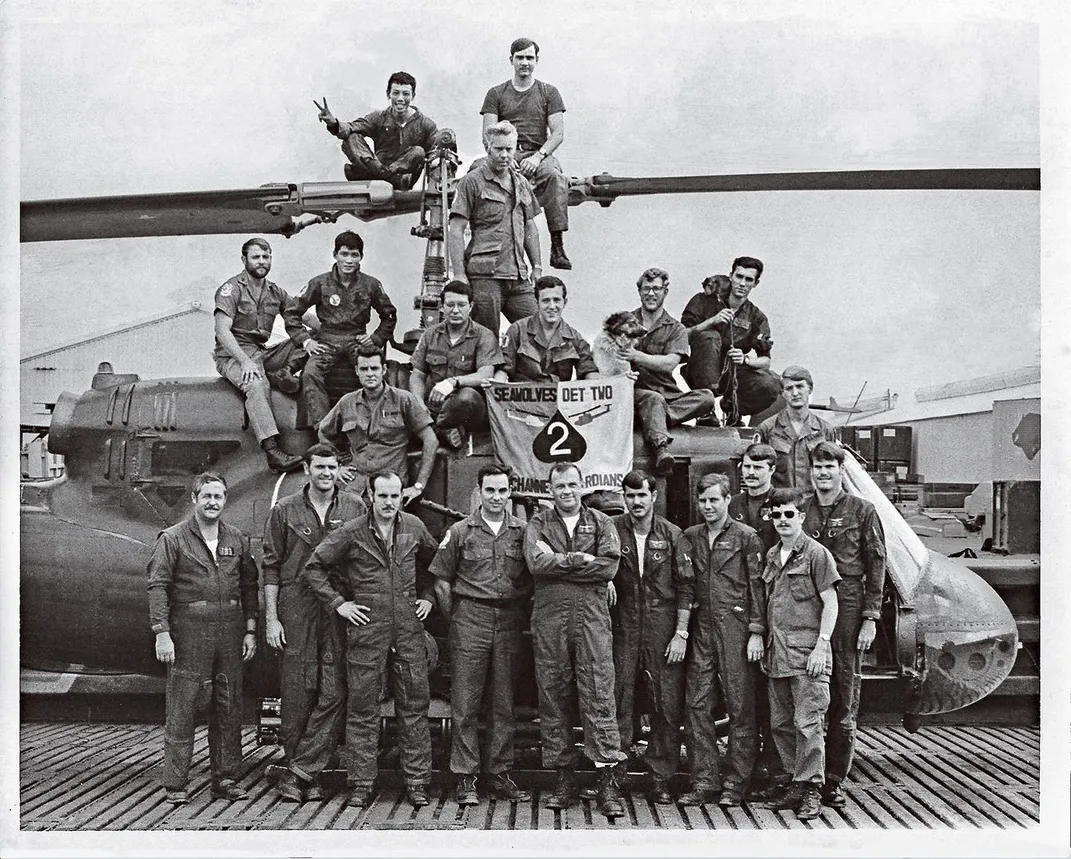
Wallin still regales friends with stories about the battle-worn surplus Army Hueys that the Seawolves flew. While dropping off visiting civilians at Saigon’s Tan Son Nhut airport in late 1971, Wallin’s crew received a cheery radio call from an Army pilot: “Hey Navy, got shot down in that bird in Tet of ’68.”
At the height of their strength, in 1971, the Seawolves fielded 29 Huey gunships, supplemented by a smaller number of unarmed UH-1Ls, or “slicks,” for logistics flights. At the same time, American forces started to withdraw from Vietnam, ending involvement in what was then the longest war in U.S. history. In March 1972, after five years of continual combat, the Seawolves were disbanded without fanfare at Binh Thuy. The last American combat troops left Vietnam a year later, and in 1975 North Vietnamese forces took Saigon. Though relatively unsung in the saga of the air war in Vietnam, HA(L)-3 was one of the war’s most highly decorated units, and suffered high casualties: 44 men killed and more than 200 wounded.
Though HA(L)-3 was disbanded, the Navy was out of the special forces air support role for only a brief time. Today two Navy helicopter squadrons, HSC-84 and -85, are both dedicated to special warfare and combat search-and-rescue missions (HSC-84 is scheduled to shut down in this fiscal year).
Patrick Rodgers, an ex-Army Huey crew chief and the chief pilot of the Wings & Rotors Air Museum of Murrieta, California, was helping to rebuild a UH-1B when he discovered that many of its parts were from an original Seawolf Huey. “Man, this is rare,” Rogers thought. “Their story is not well known and kind of intrigued me,” he says.
In 2009, the museum’s Huey was restored to flying condition as Seawolf 321 and now visits events around the country, sometimes with former Seawolves along for the ride. But while the early-model Huey in Navy markings is a popular attraction at airshows, it’s not unusual for people to question the accuracy of its livery. Mechanic and museum marketing director Shayne Meder says that people confront the team, saying, “Oh, the Navy never flew those.” “Well,” says Meder, “then the education begins.”

